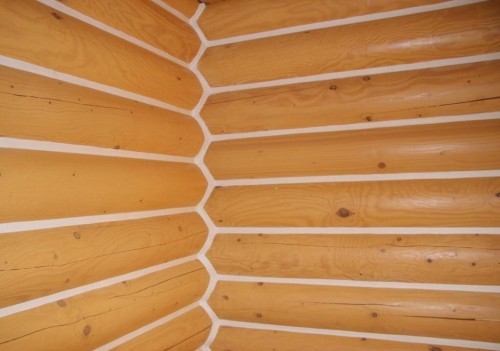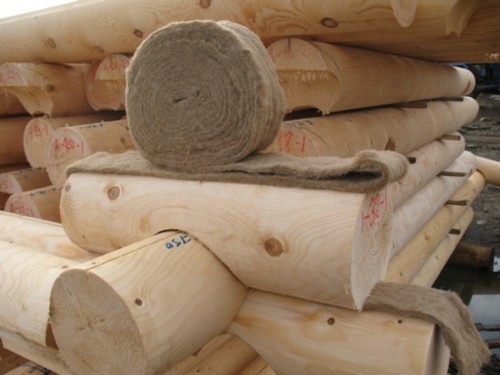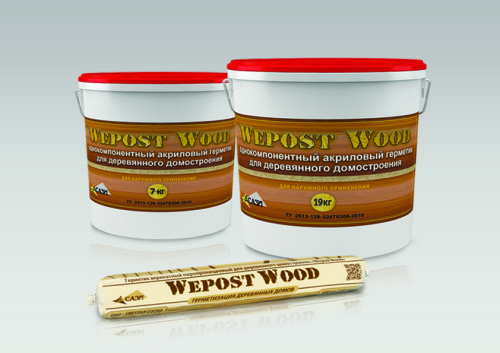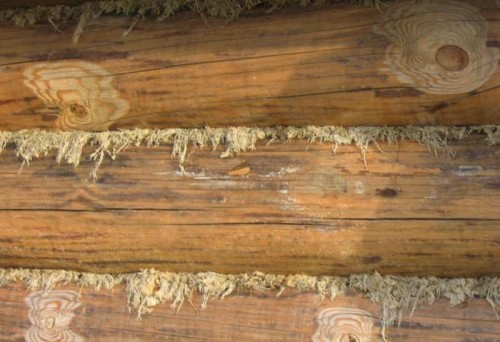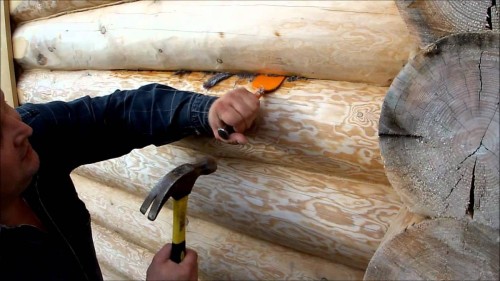A long operating period and absolute environmental friendliness - characteristics inherent in wood buildings. But to achieve the maximum cozy, it is necessary to periodically carry out the repair of a wooden house cut. One of the types of such repairs is the cavity of the seams.
Content
Wooden House Sir Crop Cutting Backgrounds
There are factors in which the cuts of the seams are required:
- construction of a new house;
- the presence of large heat loss and high humidity;
- the appearance of drafts;
- unattractive appearance.
When the tree is dried out over time, slots appear between the logs. There is a significant heat loss of residential rooms. In addition, the seams are covered with condensate. What leads to the rotting of a wooden surface.
To some extent, this problem can solve the laying of the interventovascular insulation when bookmarking their hands of a wooden house cut. But after a few years, the gaps between the crowns will appear anyway, in the door and window openings. In this case, only a caulkite will help, the need for which occurs during the first 5 years after the construction of the building.
Selection of material
For the cavities of the seams in a wooden house, various materials that are divided into two main groups can be used:
- natural (Jute, Len, Pakle, Moss and Wool);
- synthetic (sealants of polymers).
Natural products are less elastic, rather than acrylic sealants. But, on the other hand, they "breathe", and during wetting dried over a small amount of time.
Polymeric materials are characterized by excellent adhesion properties and elasticity. But there is a significant drawback - the sealant does not miss moisture. And this is fraught with rotting of wood.
Natural materials
Konopka seams of packles refers to the most complex and inefficient process. This is explained by the fact that the drying of wood and the presence of a wet environment cause damage to the insulation. The pass will have to delete and add the seams in a new one.
More popular material is jute. For this material, excellent indicators of hygroscopicity and strength are characteristic. Even with humidity, within 75-80%, the jute absorbs no more than 20% of moisture, while remaining dry dry. In addition, the insulation is not interested in birds.
It is not recommended to use Jute felt, since it consists of flax fibers. Such material rotates and can be destroyed by moth or birds.
These disadvantages are characteristic of both insulation made from flax (Eurolian and linen packley). Benefits of linen products:
- available price of cachatka seams;
- low thermal conductivity;
- elasticity;
- long operational period.
A good solution will be the use of combined products (such as Len-Jute) or flattery. The last material has sufficient rigidity and strength, because when it is manufactured, linseed dust is pressed.
Moss is an excellent antiseptic that does not allow the appearance of mold or rot. Capacles of seams can only be carried out by two varieties: forest and red marsh moss. The only nuance is that the laying of the material between the logs should be made when building a church.
The use of moss for cacked is a rather time consuming process. It needs to be cleaned from the ground and dry high quality. After that, it should be insulated correctly to distribute over the crowns in the transverse direction with the allen up to 15 cm. The minimum thickness of the layer should be 0.1 m.
The main distinguishing feature of the wool is excellent energy-saving quality. This is due to the high elasticity of the material. Wool is able to fill all the space between the logs. Shut-off seams do not need to be repeated warming. The only lack of woolen cacopa is the high cost of technology.
Synthetic products
A more efficient way of wood insulation of a wooden house is the use of polymer sealants. Some of them are able to stretch in the amount of up to 200%. Warming up the wooden house with the help of sealant is also called a warm seam. Now directly about how to process the seams after the cacopa.
The best goods are:
- american sealants perma-chink, Energy Seal, Log Jam;
- russian sealants Eurotek, Atakamast-125, Wepost Wood;
- o-cord from Polyeneetylene Robiband.
The most famous (but also expensive) material - PERMA-chink sealant. With it, it is possible to high-qualityly close the seams with a thickness of up to 10 cm. A sealant is for sale in a capacity with a volume of 22 l, which is enough for sealing 113-118 m with a thickness of 25 mm. A significant drawback of the material is quite a high price.
Among domestic products The best reviews received a sealant for the cavulus of the seams of the wooden house Eurotex. With it can be carried out:
- sealing of slots and seams between the logs both from the outer and on the inside of the chopped construction;
- close up of cracks on a bar and logs.
For Eurotex, high elasticity and vapor permeability are characteristic features. The consumption of the material is 1 kg / 6 m of the seam of 1 cm thick.
Atakamast-125 sealant allows you to give a seam required shade. The suture canopy can be performed at low temperatures (including - 15ºС) and cover the wet surface. Atakamast-125 is applied to any type of surface: horizontal, vertical or inclined (at different angles). The consumption of material ranges from 80 (timber) to 200 (chopped house) GR. m.
The undoubted advantage Wepost Wood mezhventsovogo sealant is a lifetime, which is more than 10 years. This is because the maximum deformation of the material can reach 350%. Wepost Wood best suited to conditions in Russia and is the most optimal solution for the ratio of the price and quality. Consumption - 140-150 g / rm. m. at the joint width of 1-2 cm.
Sealing cord of polyethylene foam Robiband - excellent moisture-resistant and heat-insulating material, which has closed pores. Upon contact with the air flow line expands independently and perfectly closes the space between the logs.
We define technology grouting
It is clear that the issue of what is best konopatka or warm seam, each person will be guided by your preferences and financial capabilities. But there are some nuances to be aware of the homeowners.
The main criteria for comparing the two technologies are:
- frequency of application;
- creating a continuous layer;
- the cost of the work;
- environmental properties of the material.
Caulking seams with natural materials is carried out several times at intervals of 2-3 years. Wherein the insulation might come into disrepair when exposed to both environmental factors and destroyed by birds or insects. Sealant is used 1 time in 10-15 years. This material is not attractive for living organisms.
Shrinkage of the wooden house jute, hemp and linen remain at fixed locations. The materials do not cover the arising gap. The sealant has excellent adhesion qualities, resulting in a moisture-proof film. In the event of deformation changes the film is stretched (or compressed).
The use of natural materials for sealing joints of the wooden house - the most inexpensive thermal insulation technology. But in the case of multiple works of their cost is comparable to the sealing gaps. And when using the sealant heating costs will be reduced by 20-25%.
With regard to environmental properties, jute, flax, hemp look clearly preferable compositions Perma-Chink, Eurotex or Wepost Wood. Ideal - hold caulking warm seam.
Technology of the caulking joints Log houses Wooden houses
Traditional konopatka gaps between the logs jute, hemp or flax articles can be accomplished in two ways:
- Stretching. The insulation is stretched and inserted between the crowns using a special tool. The space must be filled completely. From the outer part, the material is left with a 10-centimeter reserve, which is rolled into the roller and placed between the logs.
- In the set. This technology is used in the presence of a wide seam. From the insulation make several loops that fill the seams.
Croplate is carried out in a circular direction from the bottom of the building. First, the slots are filled around the entire perimeter of the wooden house. You can not pure the walls separately from each other. This is fraught with a blockage of the building due to the uneven arrangement of the crowns.
When seaming seams, the insulation is laid out throughout the perimeter of the wall. The process itself begins with an angle, since it is the most difficult area. In the process of cauldation, close attention is paid to the insulation to turn into a dense roller. The material should not be turned over.
Canopic seams can be carried out using conventional glass gambles (IsOVER or URSA):
- the insulation is cut into "sausages";
- they close the slits between the logs;
- a plaster grid is attached to the seams (roofing nails are used, which have a wide hat);
- the extreme part of the mesh worst inside the gap;
- concrete solution is close to interventovation space (to improve the strength and moisture-resistant properties of concrete can be mixed with a small amount of liquid glass);
- watching the surface from the outer part of the house is carried out with a slope designed for water drain;
- after grappling concrete, it can be covered with textured plaster.
If a sealant will be used for seams of seams of a wooden house, then you will need:
- polysto foam cord (pre-standing in the gap);
- construction gun with a capacity (for more convenient and fast application);
- thin elastic spatula (for uniformly smoothing material);
- coloring tape (to obtain a perfectly smooth surface).
Video about the pantry of the seams of a wooden house:


